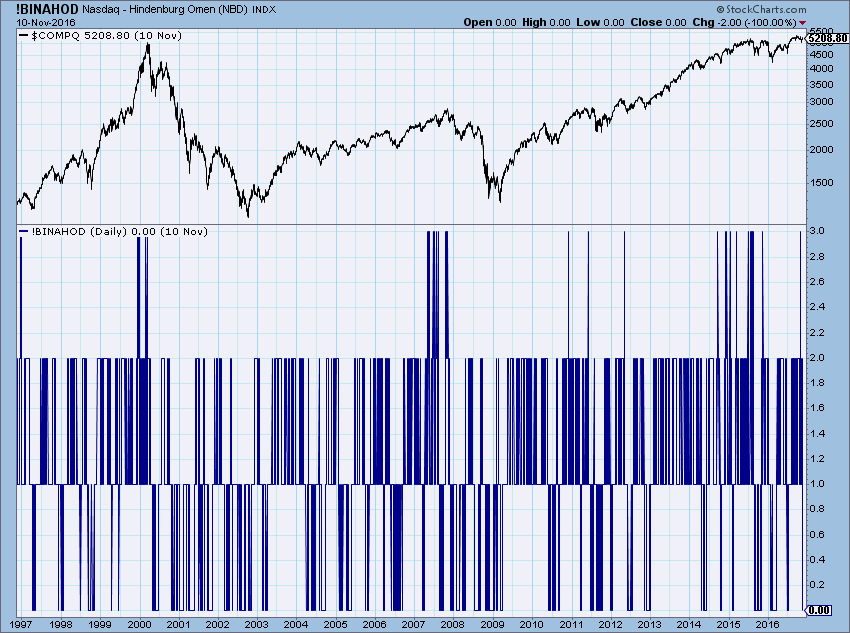 There are many who are now talking about the Hindenburg Omen so I thought I would explain what it is and where it now stands. This is easy since I knew Jim Miekka (creator of the Omen) as he offered to assist me when I included some of his material in my “The Complete Guide to Market Breadth Indicators.” Jim also made many other contributions to technical analysis, including a mathematical process to refresh the McClellan Summation Index.
There are many who are now talking about the Hindenburg Omen so I thought I would explain what it is and where it now stands. This is easy since I knew Jim Miekka (creator of the Omen) as he offered to assist me when I included some of his material in my “The Complete Guide to Market Breadth Indicators.” Jim also made many other contributions to technical analysis, including a mathematical process to refresh the McClellan Summation Index.
The Hindenburg Omen is an indication of market tops and was created by James R. Miekka and dubbed “the Hindenburg Omen” by Kennedy Gammage of the Richland Report. You’ll recognize Kennedy as the former provider of the McClellan Oscillator and Summation Index numbers on FNN and now, CNBC television.
The remaining material on this indicator was written by the late James R. Miekka, creator of the Hindenburg Omen:
The Hindenburg Omen is a sell signal that occurs when NYSE new highs and new lows each exceed 2.8% of advances plus declines on the same day. In addition, the NYSE index must be above the value it had 50 trading days (ten weeks) ago. Once the signal has occurred, it is valid for 30 trading days. Any additional signals given during the 30-day period should be ignored. During the 30 days, the signal is activated whenever the McClellan Oscillator (MCO) is negative, but deactivated whenever the MCO is positive. The signal starting point was originally calculated to be when NH and NL equaled or exceeded 2.4% of total issues traded, but was later simplified to 2.8% of advances plus declines. This signal was developed as an improvement upon the Split Market Sell Signal developed by Gerald Appel. Appel’s signal used a fixed number of new highs and new lows (45 of each), which was not indexed for increasing numbers of shares trades, and his signal did not require validation by the MCO being negative.
This signal generally occurs after a rising market when the number of new lows is rising rapidly, but when new highs are still quite numerous. The large number of highs and lows suggests that the market is indecisive and probably at a turning point. Of course, a similar scenario can occur during a falling market when new lows are numerous but new highs begin to rise rapidly. The latter condition would suggest that such market indecision could be a buy signal in a falling market. This has not been studied, at least not by James Miekka, other than to note that the sell signal is not reliable when NYSE is below its ten-weeks-ago value. To utilize the Hindenburg Omen signal, Miekka suggests the following:
1. Go short the market whenever the McClellan Oscillator is negative during the 30 trading days after a valid signal has been given.
2. Exit the market for 30 days whenever the signal is given, or at least be wary of any new stock or stock index purchases while the signal is valid and especially if it is activated by a negative MCO.
By exiting the market when a signal was given on September 23, 1987, you would have avoided the crash of 1987.
Jim Miekka has provided a significant indicator of market danger. An indicator developed from a logical point of view is usually one that will serve you well. This one does just that. In chart A and chart B I have tried to recreate this indicator as closely to Miekka’s parameters as I can. Any difference between the chart signals and Jim’s actual are a fault with my programming.
The top set of spikes in Chart A (NYSE version) show some recent signals from the Omen.
 Chart A
Chart A
StockCharts.com’s Symbol: !BINYHOD
Below is the Hindenburg Omen for the Nasdaq market. You can see that there is a recent signal. Visually it appears to work better with the Nasdaq data instead of the NYSE data. I used only Nasdaq data in my models.
 Chart B
Chart B
StockCharts.com’s Symbol: !BINAHOD
These Hindenburg Omen indicators along with about 500 more breadth-related indicators are available in my ChartPack.
References:
Gammage, Kennedy, 2004,The Richland Report, LaJolla, CA.
Miekka, James R., The Sudbury Bull and Bear Report, St. Petersburg, FL.
Often in the past when an "Omen" occurred all the naysayers proclaimed it was broken because a top never materialized. Remember it is just identifying a condition that is often prevalent at tops, nothing more. Anyone who has been involved with the markets and in particular, technical analysis, knows that tops are always more difficult to identify during the often long periods of distribution. Except of course, for all the perma-bears who will eventually be correct and won't let you forget it when they are.
Jim passed away a few years ago. You should Google him and read what a remarkable guy he was.
Dance with the Trend,
Greg Morris






